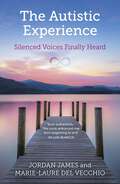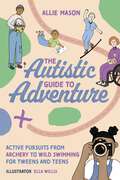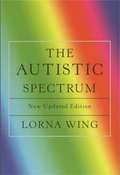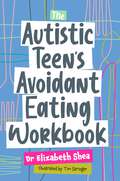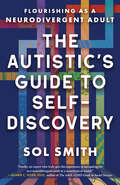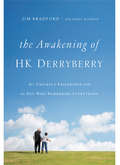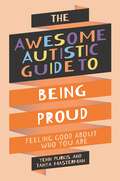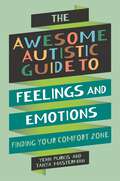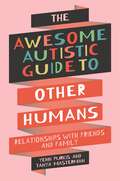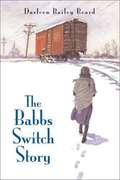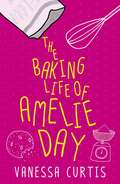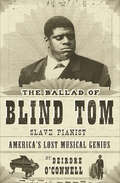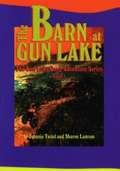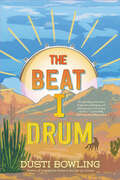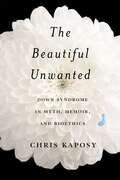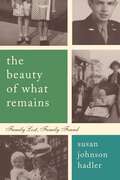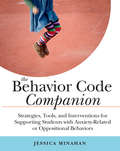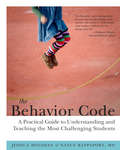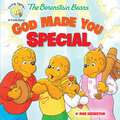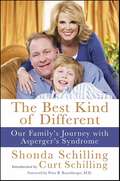- Table View
- List View
The Autistic Experience: Silenced Voices Finally Heard
by Marie-Laure Del Vecchio Joe James'My autism and ADHD are as integral to me as my sense of personal ethics' Lettie 'That clearly visible line for everyone else was non-existent for me, and often I was ridiculed' Parnel 'Questioning authority? I was seeking clarification!' Loukas 'I hate eye contact but I do it in order to look normal' DianaThese are Autistic Voices, and this is The Autistic Experience. Curated by psychologist and psychotherapist Marie-Laure Del Vecchio, and the Autistic Photographer, Joe James, whose own experience of trauma drives his mission to create an inclusive society. This book is a brave, unflinching and ultimately optimistic collection of stories about life in the lens of autism. Sometimes sad, sometimes funny, often shocking and always eye-opening, these stories from people across the globe explore all aspects of autistic life - from the earliest childhood memories to the challenges facing the autistic parent or grandparent. From school days to office life, from teenagers to those in their seventies, across all genders, from people who are homeless to NASA scientists, The Autistic Experience explodes the myths around autism and celebrates the right to be autistic.Taking a deep dive into controversies like the 'causes' of autism this is, above all, a book that speaks to the hundreds of thousands of people both with and without an autism diagnosis who need to know that to live in a more inclusive, adjusted and autism-friendly environment is a right worth fighting for.
The Autistic Guide to Adventure: Active Pursuits from Archery to Wild Swimming for Tweens and Teens
by Allie MasonIt's time for a new generation of autistic adventurers!Outdoor adventuring can be life changing - it makes you physically and mentally stronger, takes you to new places and introduces you to new friends, as well as being an exhilarating challenge - but it can be stressful when there are unexpected social and sensory challenges involved. Allie Mason, autistic adventurer extraordinaire, is here to help. Join Allie as she introduces activities ranging from archery to stargazing, sailing to fossil hunting, snorkeling to nature-writing - and so much more. Each easily digestible factsheet comes with a short introduction, a summary of the sensory experiences involved, suggestions on approaching activities for when you're just getting started, as well as a handy budgeting system. With personal anecdotes and interviews with awesome autistic athletes, this book will give you the support you need to take on the great outdoors.
The Autistic Spectrum: Revised edition
by Lorna Wing'Authoritative, compassionate and commonsensical . . . an honest, sensitive and thorough introduction to understanding and living with autism . . . highly recommended.' - Psychological Medicine'Packed with down to earth, practical ideas . . . readable, interesting . . . informative . . . if you buy only one title about autism this year it should be this one.' - Collette Dritte, Nursery WorldOver 500,000 people of all ages in the UK have disorders in the autistic spectrum. About one-third also have varying degrees of learning difficulty. All have impairment of social interaction, communication and imagination - the world appears a bewildering and sometimes frightening place. This acclaimed, authoritative guide explains how people with autism experience the world and why they need an organized, structured environment, presenting a window into the world of those with the disorder. Wing suggests ways of improving communication, developing abilities and widening social interaction, and how to cope with stresses within the family.
The Autistic Spectrum: Revised edition
by Ms Lorna Wing'Authoritative, compassionate and commonsensical . . . an honest, sensitive and thorough introduction to understanding and living with autism . . . highly recommended.' - Psychological Medicine'Packed with down to earth, practical ideas . . . readable, interesting . . . informative . . . if you buy only one title about autism this year it should be this one.' - Collette Dritte, Nursery WorldOver 500,000 people of all ages in the UK have disorders in the autistic spectrum. About one-third also have varying degrees of learning difficulty. All have impairment of social interaction, communication and imagination - the world appears a bewildering and sometimes frightening place. This acclaimed, authoritative guide explains how people with autism experience the world and why they need an organized, structured environment, presenting a window into the world of those with the disorder. Wing suggests ways of improving communication, developing abilities and widening social interaction, and how to cope with stresses within the family.
The Autistic Teen's Avoidant Eating Workbook
by Elizabeth SheaWhat should I be aware of when trying new foods?Am I ready to change my eating patterns?How can I eat with other people?Food can come with all sorts of challenges - sensory issues, social pressure, loss of control - and so making choices about what foods to eat, and coping with mealtimes can be stressful - especially when other people are involved.If you are neurodivergent and looking to change your relationship with food, this interactive, accessible guide is the perfect companion. You might stick to the same 'safe' foods all the time, be attached to specific mealtime rituals, or struggle to know whether you are hungry or full. This guide will help you recognise the signs of avoidant eating, cope with food related anxieties and manage sensory overload, as well as the particular social stresses of communal eating.With top tips, a progress tracker, quizzes and worksheets, this is an engaging and informative resource for teens and parents alike.
The Autistic's Guide to Self-Discovery: Flourishing as a Neurodivergent Adult
by Sol SmithLive Authentically and Function Effectively in All Areas of Your Life In this first-of-its-kind book, Sol Smith combines current research, his personal experience as a late-diagnosed autistic adult, and lessons learned as an educator to show how you can transcend common mischaracterizations, overcome shame, and gain the skills to flourish. Sol knows that neurodivergent people often feel that nothing they have been taught relates to how they experience the world. To resolve this conflict, they try to change or mask who they are, which can cause isolation, depression, and anxiety. He advises the opposite: Understand yourself, accept yourself, and reduce conflict. Designed to help you peel away the shell of inadequacy and self-blame that often comes with neurodivergence, The Autistic’s Guide to Self-Discovery offers the necessary tools and knowledge to function effectively at home, at work, and in the wider world.
The Awakening of HK Derryberry: My Unlikely Friendship with the Boy Who Remembers Everything
by Andy Hardin Jim BradfordThe Awakening of HK Derryberry is the inspiring story of how one man was willing to step out of his upper middle-class world into the life of a young, disabled boy with a dismal future. Little did Jim Bradford know the transformational potential of that friendship--for HK and himself. HK Derryberry came into the world with the odds stacked heavily against him. He was taken from his unmarried mother's womb three months prematurely when she was killed in a car wreck. After ninety-six days of seesawing between life and death, HK's grandmother took him home. One Saturday morning Jim Bradford, a successful businessman in his mid-fifties, happens into Mrs. Winner's Chicken and Biscuits and sees a nine-year-old's head pressed down against a black plastic boom box with a crooked antenna and three strips of silver duct tape stretched across the battery cover. He can't help but notice the long, white plastic braces on each of the child's legs. Mr. Bradford learns that HK's grandmother is forced to bring him to the fast-food restaurant where she works, leaving him to sit alone all day at a small table, with only his boom box for company. On subsequent Saturdays Jim feels drawn back to the restaurant to meet with HK and begins spending every weekend with him. Eventually it becomes apparent that buried beneath HK's severe disabilities is one spectacular ability. He is diagnosed with Highly Superior Autobiographical Memory (HSAM), which involves superlative powers of recollection that enable him to remember everything that has happened to him since the age of three. Less than one hundred people have been diagnosed with HSAM, but none of them have the physical disabilities of HK Derryberry.
The Awesome Autistic Go-To Guide: A Practical Handbook for Autistic Teens and Tweens
by Yenn Purkis Tanya MastermanThis book explores what it feels like to be a young person on the autism spectrum and looks at all the brilliant things people on the autism spectrum can do.Full of insights about being awesome and autistic, this book celebrates the strengths of understanding the world in a different way. It looks at all the reasons being you and thinking differently can be totally awesome! It also has tips for managing tricky situations such as meltdowns, sensory differences and anxiety. It includes fun activities and diary pages where you can write your thoughts and feelings to help you concentrate on your strengths and work on your challenges.This book helps you develop the confidence to be who you are and help you live life with as little stress and anxiety as possible.
The Awesome Autistic Guide to Being Proud: Feeling Good About Who You Are (Awesome Guides for Amazing Autistic Kids)
by Yenn Purkis Tanya MastermanWelcome to the autistic community! We're very glad you're here!Sometimes it can be difficult to feel proud of who you are. Maybe you feel different from other people or struggle to fit in - there is no need to worry! Yenn, Tanya and a tiny meerkat called Min are here to help you discover how to feel proud to be you.From learning about the autistic community, to finding like-minded friends and connecting with others, this book will give you everything you need to ask the question 'what does it mean to be me?' Learn alongside Min how the special things that make you YOU can also help find your own community.Discover your own strengths, boost your confidence, and learn how to start your journey as an awesome autistic person with the community by your side
The Awesome Autistic Guide to Feelings and Emotions: Finding Your Comfort Zone (Awesome Guides for Amazing Autistic Kids)
by Yenn Purkis Tanya MastermanUnderstanding your feelings and emotions is an incredibly important part of learning to become your most awesome autistic self!Yenn, Tanya and a tiny meerkat called Min are here to help you find out everything you need to know about your feelings and emotions, using tips and tricks they have picked up along the way to help you calm your brain down when it feels overloaded.From anger and worry to sadness and joy, emotions can come in all shapes and sizes with some feeling really big and others feeling much smaller (or even feeling like nothing), this book explores why we experience certain emotions, what they mean and how we can find the ultimate autistic comfort zone!
The Awesome Autistic Guide to Other Humans: Relationships with Friends and Family (Awesome Guides for Amazing Autistic Kids)
by Yenn Purkis Tanya MastermanLet's face it, other humans can be difficult to understand sometimes!There is no need to worry! Yenn, Tanya and a tiny meerkat called Min are here to help you find out everything you need to know about friendships, improving relationships with your family members, and how to deal with disagreements that can arise with the people in your life.Answering the difficult questions like 'What makes a good friend?' and 'Why do adults tell me to do things?' this book gives you helpful tips, tricks, and advice you need to help you understand other humans whilst staying true to your own awesome autistic self!
The Babbs Switch Story
by Darleen Bailey BeardIn 1924, twelve-year-old Ruthie finds her life in a small Oklahoma town complicated by the behaviour of her older sister Daphne, an object of ridicule and dislike because of her limited mental abilities.
The Baking Life Of Amelie Day
by Vanessa Curtis Jane EcclesThe Baking Life ofAmelie Day combines the British baking obsession with a fabulously determined and honest young heroine. Amelie Day loves to bake so she's thrilled when she makes it through to the quarter-finals of a national competition, 'Best Teen Baker of the Year'. There's just one small problem. Amelie has Cystic Fibrosis. But Amelie is determined to prove she has what it takes to win the competition, even when her over-protective mother forbids her from taking part. Publishing to coincide with series five of the BAFTA Award-winning British TV show, The Great British Bake Off, which is airing on BBC One for the first time. Original author recipes feature throughout.
The Ballad of Blind Tom, Slave Pianist: America's Lost Musical Genius
by Deirdre O'ConnellThis biography of a musical genius who went from slavery to international stardom is a “vivid, carefully researched narrative reflects the tenor of the” (Publishers Weekly). Born into slavery in Georgia, Tom Wiggins died an international celebrity in New York in 1908. His life was one of the most bizarre and moving episodes in American history. Born blind and autistic—and therefore unable to work with other slaves—Tom was left to his own devices. He was mesmerized by the music of the family’s young daughters, and by the time he was four, Tom was playing tunes on the piano. Eventually freed from slavery, “Blind Tom” toured the country and the world, dazzling audiences that included celebrities like Mark Twain and the Queen of England. Considered both a genius and a novelty act, Blind Tom embodied contradictions—a star and a freak, freed from slavery yet still under the control of his white guardian. His life offers a window into the culture of celebrity and racism at the turn of the twentieth century. In this rollicking and heartrending book, O’Connell takes us through the life (and three separate deaths) of Blind Tom Wiggins, restoring to the modern reader this unusual yet quintessentially American life.
The Barn at Gun Lake (The Gun Lake Gang Adventure Series #1)
by Sharon Lamson Johnnie TuitelJohnnie, who has cerebral palsy and is in a wheelchair, finds himself with two challenges: gaining acceptance from his newfound friends and solving an unusual pirating mystery. He does not find his disability to be a handicap, just a challenge to overcome in order to be accepted by the kids in his new town. To join the Gun Lake Gang, he needs to complete an initiation. He must go to the old barn by the lake and bring back something to prove he was there. He stumbles onto a CD-pirating ring while in the barn and the gang decides to find out who is running it. The kids in the gang are realistic. Some of them accept Johnnie, some question his disability, and one boy is uncomfortable with the situation but tries, with reluctance, to accept what Johnnie has to offer.
The Basics: A Curriculum for Co-Occurring Psychiatric and Substance Disorders Volume I & II (Second Edition)
by Rhonda MckillipIs integrated treatment a priority? A requirement? Do you attend lots of training? Buy lots of books? Yet find it a challenge to know exactly what to say to a psychiatric consumer with an addictive disorder or an addiction client with a psychiatric disorder? THE BASICS, SECOND EDITION is the complete solution with detailed lesson content and handouts for groups, topics and information for individual sessions, and comprehensive cross training education for mental health and chemical dependency professionals. Integrating your treatment program, providing dual diagnoses educational material, and cross-training your staff doesn't get any easier than this! THE BASICS eliminates gaps. When a publication focuses first on training the professional, the professional must transfer the knowledge into a useful format and into conversational language. THE BASICS is the treatment by first providing ready to present material. A professional is then simultaneously cross-trained on psychiatric and substance disorders by learning literally how to provide treatment to the dually diagnosed population. With over 1,600 references, THE BASICS is a Consensus-Based Best Practice. It is specifically designed to match the evidence based best practices consistent with the CCISC Model (Minkoff & Cline), Stages of Change Model (Prochaska & DiClemente), and Motivational Interviewing (Miller & Rollnick). Treatment participants benefit by consistent psychoeducation in groups, in 1:1's, and throughout a system of care. Group participants benefit by practicing skills with the use of reproducible Worksheets. Professionals benefit by a detailed curriculum written in a "conversational style." Administration and staff benefit by drastically reducing hours devoted to program development. Direct service providers benefit by a continuity of material for group and 1x1's.
The Beat I Drum (Life of a Cactus #3)
by Dusti Bowling&“This story was everything I wanted it to be. Heartfelt, thoughtful, and most of all . . . full of hope. I loved it!&” —Lindsay Currie, New York Times bestselling author of The Mystery of Locked RoomsConnor, beloved best friend of Aven Green from Insignificant Events in the Life of a Cactus, tells his own story in this poignant and heartwarming tale about overcoming the challenges of life with Tourette&’s. Connor Bradley is dreading the first day of high school. Not just because he is new, or because he misses his best friends, but because he knows the other kids won&’t understand his barking and tics. Connor has Tourette Syndrome, and every day has been a challenge—from the mimicking to the laughing, the questions, and the stares. It turns out school isn&’t quite as bad as he expected. Connor forms a fast friendship with a girl who also has Tourette&’s and is welcomed into her accepting circle of friends. He also meets a special music teacher who encourages him to take up the drums to manage his stress, and maybe get a break from his tics. But Connor&’s world is turned upside down when his absent father reappears and a bully starts to escalate at school. All these problems—with family, with friends, and even with himself—build and build until Connor feels ready to explode. Will a surprising revelation save him and help him find his beat again? Endearing and authentic, The Beat I Drum offers an empathetic look at a misunderstood syndrome, the therapeutic value of music, and the power of forgiveness.
The Beautiful Unwanted: Down Syndrome in Myth, Memoir, and Bioethics
by Chris KaposyPrenatal genetic testing has changed the circumstances under which parents choose what pregnancies to carry to term. Some have predicted that as a result of parents’ choices, people with Down syndrome will disappear from our communities in the near future. Chris Kaposy, a bioethicist who has a son with Down syndrome, reflects on parenting his son in the midst of this supposed disappearance.Writing from a pro-choice, disability-positive perspective, Kaposy presents some of the decades-old bioethical controversies involving children with Down syndrome, illustrating a prehistory of disappearance that has shaped current attitudes toward intellectual disability. Layered throughout this history are elements of Kaposy’s personal experience with his son and family. Transcending monograph and memoir, The Beautiful Unwanted draws creatively upon the past and the present, upon myth, history, science, and personal stories, to present the world of families that include children with Down syndrome from a series of uncommon perspectives. This account encompasses the changeling myths of Newfoundland, the “discovery” of Down syndrome by John Langdon Down and Jérôme Lejeune, and the twentieth-century experience of institutionalization, as well as recent advances in reproductive technology.We must recognize that we have some control over the future, Kaposy argues, and we must ask what kind of future we want for those who have intellectual disabilities. The Beautiful Unwanted poses this question in a way that is engaging, often bewildering, and always fascinating.
The Beauty of What Remains: Family Lost, Family Found
by Susan HadlerWhere are they now, the lost, the forgotten? With the love in her mother&’s silence as her guide, Susan Johnson Hadler began a quest to find out who the missing people in her family were and what happened to them. The search led her to Germany, where her father was killed just before the end of WWII; then to a Buddhist monastery in France, where she learned new ways to relate to life and death; and ultimately to a state mental hospital in Ohio, where the family abandoned her mother&’s older sister years earlier. She believed that her aunt had died—but Hadler, to her great surprise, found her still alive at age ninety-four. And the story didn&’t end there. Captivating and often heartwrenching, The Beauty of What Remains is a story of liberating a family from secrets, ghosts, and untold pain; of reuniting four generations shattered by shame and fear; and of finding the ineffable beauty in what remains.
The Behavior Code Companion: Strategies, Tools, and Interventions for Supporting Students with Anxiety-Related and Oppositional Behaviors
by Jessica MinahanSince its publication in 2012, The Behavior Code: A Practical Guide to Understanding and Teaching the Most Challenging Students has helped countless classroom teachers, special educators, and others implement an effective, new approach to teaching focused on skill-building, practical interventions, and purposeful, positive interactions with students who have mental health disorders. Based on the success of the previous book, author Jessica Minahan has written this companion guide for educators seeking additional guidance for creating and implementing successful behavior intervention plans ("FAIR Plans") for the students teachers worry about the most: those with anxiety-related or oppositional behaviors. Minahan takes readers step-by-step through the process of understanding and practicing the components of a FAIR behavior intervention plan so that they or a team can immediately customize it and put it to work in classrooms. Additional tips on creating interventions, as well as checklists to help with implementation and monitoring progress, are also included. Packed with brainstorming and reflection exercises, planning activities, templates, case studies, recommended apps, and other technology resources, The Behavior Code Companion will help educators create optimal classroom environments for all students.
The Behavior Code Companion: Strategies, Tools, and Interventions for Supporting Students with Anxiety-Related or Oppositional Behaviors
by Jessica MinahanSince its publication in 2012, The Behavior Code: A Practical Guide to Understanding and Teaching the Most Challenging Students has helped countless classroom teachers, special educators, and others implement an effective, new approach to teaching focused on skill-building, practical interventions, and purposeful, positive interactions with students who have mental health disorders. Based on the success of the previous book, author Jessica Minahan has written this companion guide for educators seeking additional guidance for creating and implementing successful behavior intervention plans (&“FAIR Plans&”) for the students teachers worry about the most: those with anxiety-related or oppositional behaviors. Minahan takes readers step-by-step through the process of understanding and practicing the components of a FAIR behavior intervention plan so that they or a team can immediately customize it and put it to work in classrooms. Additional tips on creating interventions, as well as checklists to help with implementation and monitoring progress, are also included. Packed with brainstorming and reflection exercises, planning activities, templates, case studies, recommended apps, and other technology resources, The Behavior Code Companion will help educators create optimal classroom environments for all students.
The Behavior Code: A Practical Guide to Understanding and Teaching the Most Challenging Students
by Nancy Rappaport Jessica MinahanBased on a collaboration dating back nearly a decade, the authors--a behavioral analyst and a child psychiatrist--reveal their systematic approach for deciphering causes and patterns of difficult behaviors and how to match them with proven strategies for getting students back on track to learn.The Behavior Code includes user-friendly worksheets and other helpful resources.
The Behavior Code: A Practical Guide to Understanding and Teaching the Most Challenging Students
by Jessica Minahan Nancy Rappaport MDBased on a collaboration dating back nearly a decade, the authors—a behavioral analyst and a child psychiatrist—reveal their systematic approach for deciphering causes and patterns of difficult behaviors and how to match them with proven strategies for getting students back on track to learn.The Behavior Code includes user-friendly worksheets and other helpful resources.
The Berenstain Bears God Made You Special (Berenstain Bears/Living Lights: A Faith Story)
by Mike BerenstainYoung readers will enjoy reading about the Berenstain family&’s new cub friend Tommy in this addition to the Living Lights™ series of Berenstain Bears books. Children will learn how to embrace their individuality and understand God created everyone in a unique way.The Berenstain Bears God Made You Special—part of the popular Zonderkidz Living Lights series of books—is perfect for:Early readers ages 4-8Reading out loud in classrooms, during story time, and at home or bedtimeBirthday gifts, Easter, holiday gift giving, or as a new addition to your e-librarySparking authentic conversations about individuality, unity, and the reason why God made everyone differentThe Berenstain Bears God Made You Special is an addition to the Living Lights™ series that:Features the hand-drawn artwork of the Berenstain familyContinues in the much-loved footsteps of Stan and Jan Berenstain in this Berenstain Bears series of booksIs part of one of the bestselling children&’s book series ever created, with more than 250 books published and nearly 300 million copies sold to date
The Best Kind of Different: Our Family's Journey with Asperger's Syndrome
by Shonda SchillingIn The Best Kind of Different, Shonda Schilling, the wife of Major League Baseball All Star, former Boston Red Sox, and World Series championship pitcher Curt Schilling, shares the story of their son’s Asperger’s Syndrome, how it changed their lives, and what other parents can learn about this increasingly common diagnosis. Candid and compelling, The Best Kind of Different traces their family’s struggle with Asperger’s, following Curt and Shonda as they come to understand their son’s differences and in the process relearn everything they thought they knew about parenting.
